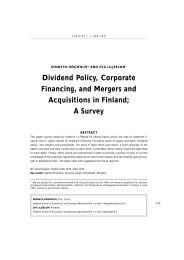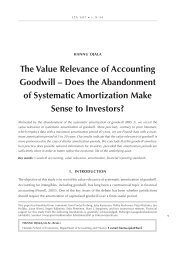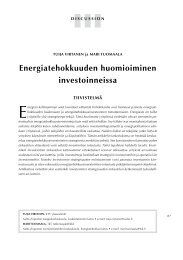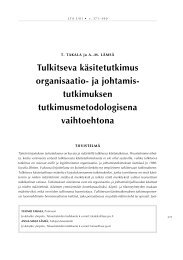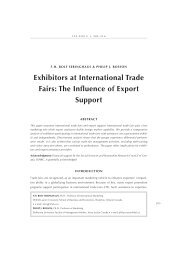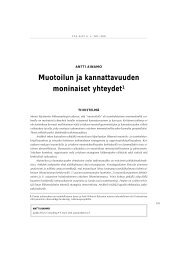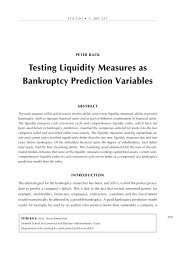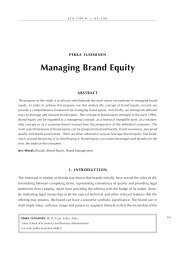<strong>LTA</strong> 2 / 0 9 • L . K u m l i n a n d V. P u t t o n e nof revenue, at the expense of other <strong>fund</strong>s [For more information on favoritism in <strong>fund</strong> families,see for example Gaspar, Massa and Matos (2006)].Finally, while some of the models suggest a negative relation between back-end loads and<strong>performance</strong> as well as between the amount of minimum investment and <strong>performance</strong>, and apositive relation between expenses and <strong>performance</strong> as well as between front-end loads and<strong>performance</strong>, these results are not consistent across different models.1 0 84.2. Determinants of <strong>manager</strong>ial <strong>ownership</strong>We also examine whether it is possible to find factors which explain the amount of <strong>manager</strong>ial<strong>ownership</strong>. Table 5 reports the ordinary least squared regression results, in which the amount of<strong>manager</strong>ial <strong>ownership</strong> is the dependent variable. Panel A documents the results, in which allsample <strong>fund</strong>s are inclded in the regressions, while Panel B shows the results when only <strong>fund</strong>swith positive <strong>manager</strong>ial <strong>ownership</strong> are inclded. Model (i) measures <strong>ownership</strong> as a percentageof the <strong>manager</strong>’s taxable wealth, Model (ii) as a percentage of the <strong>manager</strong>’s taxable employmentincome and Model (iii) as a percentage of the <strong>fund</strong>’s total assets.First, when measured as a percentage of the <strong>fund</strong>’s total assets <strong>manager</strong>ial <strong>ownership</strong> seemsto be higher in smaller <strong>fund</strong>s. This is a result consistent with previous findings and is unsurprising,since in smaller <strong>fund</strong>s, the same euro <strong>ownership</strong> comprises a larger <strong>ownership</strong> stake. However,when other <strong>ownership</strong> measures are employed, <strong>fund</strong> size seems to have no effect on the amountof <strong>ownership</strong>. Thus, the perceived correlation is more likely to be a result of the <strong>ownership</strong> measure employed and not an evidence of a relation between <strong>fund</strong> size and <strong>manager</strong>ial <strong>ownership</strong>per se.Second, consistent with the findings of Khorana et al (2007) and Evans (2008), our resultssuggest that a positive relation, if any, exists between the tenure of the <strong>manager</strong> and the amountof <strong>ownership</strong>. However, since the findings from the alternative specifications indicate no evidenceof such a relation, it is more probable that the tenure of the <strong>manager</strong> is related to the size of the<strong>fund</strong> and not to the amount of <strong>ownership</strong>.Third, while Khorana et al (2007) and Evans (2008) find that <strong>manager</strong>ial <strong>ownership</strong> is higherin US <strong>fund</strong>s with lower front-end loads and better past <strong>performance</strong>, we find no evidence of suchrelations. Instead, the results suggest that in Finland, <strong>portfolio</strong> <strong>manager</strong>s own a larger share of<strong>fund</strong>s, which belong to larger, but non-bank <strong>fund</strong> families.When the two variables of our primary interest – <strong>ownership</strong> as a percentage of the <strong>manager</strong>’staxable wealth and as a percentage of the <strong>manager</strong>’s taxable employment income – are employed,one result clearly stands o the <strong>manager</strong>s invest a higher share of their own money in <strong>fund</strong>swhich have higher risks. More precisely, for every additional percent, which the <strong>manager</strong>’s owninvestment comprises of his taxable wealth, the <strong>fund</strong> volatility increases by 16–45 basis points.
D o e s p o r t f o l i o m a n a g e r o w n e r s h i p a f f e c t f u n d p e r f o r m a n c e ? …Table 5. The determinants of <strong>manager</strong>ial <strong>ownership</strong>.The OLS regression results, in which the <strong>manager</strong>ial <strong>ownership</strong> at the end of year k (2003–2005) is thedependent variable. In model (i), <strong>ownership</strong> is measured as a percentage of the <strong>manager</strong>’s taxable wealth,in model (ii) as a percentage of the <strong>manager</strong>’s taxable income and in model (iii) as a percentage of the <strong>fund</strong>’stotal assets. The objective-adjusted Sharpe is calculated by subtracting the Sharpe of the median <strong>fund</strong> withthe matched investment objective from the <strong>fund</strong>’s Sharpe. The following control variables are in percent:volatility, expenses, front-end load and back-end load, while the log is taken from the following variables:family assets, <strong>fund</strong> size, number of shareholders and the amount of minimum investment. The tenure of the<strong>manager</strong> is measured in years. The single <strong>manager</strong> dummy is 1, if the <strong>fund</strong> is run by a single <strong>manager</strong> andotherwise 0. The bank dummy is 1, if the <strong>fund</strong> is bank-managed, and otherwise 0. The size of the <strong>fund</strong> family,the size of the <strong>fund</strong>, the number of shareholders and the tenure of the <strong>manager</strong> are measured at the end ofthe year k (2003–2005), objective-adjusted Sharpe both during year k + 1 (2004–2006) as well as duringyear k (2003–2005), and all other control variables during year k (2003–2005). Numbers in parentheses areP-values and the asterisks (*, **, ***) indicate whether the values are significant at conventional levels (10%,5% and 1% respectively).Panel A Regression results when all sample <strong>fund</strong>s are included in the regressionsVariableOwnership (% of the<strong>manager</strong>'s taxablewealth)Ownership (% of the<strong>manager</strong>'s taxableincome)Ownership (% of the<strong>fund</strong>'s total assets)(i) (ii) (iii)Objective-adjusted sharpe (contemporaneous) -0.16 -0.47 0.00(0.80) (0.38) (0.53)Objective-adjusted sharpe (lagged) -0.98 -0.23 -0.01(0.13) (0.69) (0.28)Volatility 0.16 0.13 0.00(0.06)* (0.10)* (0.42)Family assets -0.43 -0.61 0.01(0.30) (0.12) (0.09)*Expenses -1.29 -0.21 0.01(0.12) (0.80) (0.65)Fund size 0.13 0.14 -0.01(0.80) (0.78) (0.03)**Front-end load -0.29 -0.15 -0.02(0.81) (0.90) (0.16)Back-end load 0.84 -0.43 0.02(0.55) (0.75) (0.34)Tenure of the <strong>manager</strong> 0.04 -0.06 0.00(0.85) (0.77) (0.03)**Single <strong>manager</strong> dummy 1.08 1.43 0.01(0.40) (0.26) (0.39)Bank dummy 0.71 -1.79 -0.03(0.55) (0.11) (0.06)*Number of shareholders -0.29 0.49 -0.01(0.53) (0.27) (0.34)Minimum investment 0.04 0.24 0.00(0.81) (0.09)* (0.95)N 262 277 325Adjusted R 2 0.01 0.04 0.061 0 9Continued



